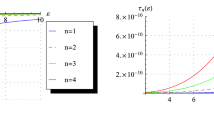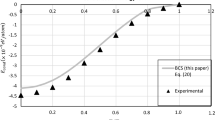Abstract
The fractional quantum Hall (FQH) effect was discovered in two-dimensional electron systems subject to a large perpendicular magnetic field nearly four decades ago. It helped launch the field of topological phases, and in addition, because of the quenching of the kinetic energy, gave new meaning to the phrase “correlated matter.” Most FQH phases are gapped like insulators and superconductors; however, a small subset with even denominator fractional fillings \(\nu \) of the Landau level, typified by \(\nu =1/2\), is found to be gapless, with a Fermi surface akin to metals. We discuss our results, obtained numerically using the infinite density matrix renormalization group scheme, on the effect of non-isotropic distortions with discrete N-fold rotational symmetry of the Fermi surface at zero magnetic field on the Fermi surface of the correlated \(\nu = 1/2\) state. We find that while the response for \(N = 2\) (elliptical) distortions is significant (and in agreement with experimental observations with no adjustable parameters), it decreases very rapidly as N is increased. Other anomalies, like resilience to breaking the Fermi surface into disjoint pieces, are also found. This highlights the difference between Fermi surfaces formed from the kinetic energy, and those formed of purely potential energy terms in the Hamiltonian.







Similar content being viewed by others
Notes
\(\delta \) may be 0 or 1/2 depending on the boundary conditions (periodic or antiperiodic) of CFs, which are emergent.
This is partly explained by the absence of a quadratic term (\(c_2=0\) by symmetry), but also due to the (unexplained, as far as we know) smallness of the symmetry-allowed cubic term \(c_3\).
References
D.C. Tsui, H.L. Stormer, A.C. Gossard, Two-dimensional magnetotransport in the extreme quantum limit. Phys. Rev. Lett. 48, 1559 (1982). https://doi.org/10.1103/PhysRevLett.48.1559
R.B. Laughlin, Anomalous quantum Hall effect: an incompressible quantum fluid with fractionally charged excitations. Phys. Rev. Lett. 50, 1395 (1983). https://doi.org/10.1103/PhysRevLett.50.1395
F.D.M. Haldane, Fractional quantization of the Hall effect: a hierarchy of incompressible quantum fluid states. Phys. Rev. Lett. 51, 605 (1983). https://doi.org/10.1103/PhysRevLett.51.605
J.K. Jain, Composite-fermion approach for the fractional quantum Hall effect. Phys. Rev. Lett. 63, 199 (1989). https://doi.org/10.1103/PhysRevLett.63.199
J.K. Jain, Composite Fermions (Cambridge University Press, Cambridge, 2007). https://doi.org/10.1017/CBO9780511607561
R.R. Du, H.L. Stormer, D.C. Tsui, L.N. Pfeiffer, K.W. West, Experimental evidence for new particles in the fractional quantum Hall effect. Phys. Rev. Lett. 70, 2944 (1993). https://doi.org/10.1103/PhysRevLett.70.2944
H.L. Stormer, D.C. Tsui, A.C. Gossard, The fractional quantum Hall effect. Rev. Mod. Phys. 71, S298 (1999). https://doi.org/10.1103/RevModPhys.71.S298
B.I. Halperin, P.A. Lee, N. Read, Theory of the half-filled Landau level. Phys. Rev. B 47, 7312 (1993). https://doi.org/10.1103/PhysRevB.47.7312
D. Kamburov, M. Shayegan, L.N. Pfeiffer, K.W. West, K.W. Baldwin, Commensurability oscillations of hole-flux composite fermions. Phys. Rev. Lett. 109, 236401 (2012). https://doi.org/10.1103/PhysRevLett.109.236401
D.T. Son, Is the composite fermion a Dirac particle? Phys. Rev. X 5, 031027 (2015). https://doi.org/10.1103/PhysRevX.5.031027
S.D. Geraedts, M.P. Zaletel, R.S.K. Mong, M.A. Metlitski, A. Vishwanath, O.I. Motrunich, The half-filled Landau level: the case for Dirac composite fermions. Science 352(6282), 197 (2016). https://doi.org/10.1126/science.aad4302
S.D. Geraedts, J. Wang, E.H. Rezayi, F.D.M. Haldane, Berry phase and model wave function in the half-filled Landau level. Phys. Rev. Lett. 121, 147202 (2018). https://doi.org/10.1103/PhysRevLett.121.147202
F.D.M. Haldane, Geometrical description of the fractional quantum Hall effect. Phys. Rev. Lett. 107, 116801 (2011). https://doi.org/10.1103/PhysRevLett.107.116801
J.B. Ketterson, R.W. Stark, Fermi surface of magnesium. I. Magnetoacoustic attenuation. Phys. Rev. 156, 748 (1967). https://doi.org/10.1103/PhysRev.156.748
N.W. Ashcroft, N.D. Mermin, Solid State Physics (Holt, Rinehart and Winston, New York, 1976). See page 306 for the complex Fermi surface of Tungsten
I. Jo, K.A.V. Rosales, M.A. Mueed, L.N. Pfeiffer, K.W. West, K.W. Baldwin, R. Winkler, M. Padmanabhan, M. Shayegan, Transference of Fermi contour anisotropy to composite fermions. Phys. Rev. Lett. 119, 016402 (2017). https://doi.org/10.1103/PhysRevLett.119.016402
D. Kamburov, M.A. Mueed, M. Shayegan, L.N. Pfeiffer, K.W. West, K.W. Baldwin, J.J.D. Lee, R. Winkler, Fermi contour anisotropy of gaas electron-flux composite fermions in parallel magnetic fields. Phys. Rev. B 89, 085304 (2014). https://doi.org/10.1103/PhysRevB.89.085304
U. Schollwöck, The density-matrix renormalization group. Rev. Mod. Phys. 77, 259 (2005). https://doi.org/10.1103/RevModPhys.77.259
M.P. Zaletel, R.S.K. Mong, F. Pollmann, Topological characterization of fractional quantum Hall ground states from microscopic Hamiltonians. Phys. Rev. Lett. 110, 236801 (2013). https://doi.org/10.1103/PhysRevLett.110.236801
M.P. Zaletel, R.S.K. Mong, F. Pollmann, E.H. Rezayi, Infinite density matrix renormalization group for multicomponent quantum Hall systems. Phys. Rev. B 91, 045115 (2015). https://doi.org/10.1103/PhysRevB.91.045115
F. Verstraete, J.I. Cirac, Matrix product states represent ground states faithfully. Phys. Rev. B 73, 094423 (2006). https://doi.org/10.1103/PhysRevB.73.094423
S.M. Girvin, A.H. MacDonald, P.M. Platzman, Collective-excitation gap in the fractional quantum Hall effect. Phys. Rev. Lett. 54, 581 (1985). https://doi.org/10.1103/PhysRevLett.54.581
M. Ippoliti, S.D. Geraedts, R.N. Bhatt, Numerical study of anisotropy in a composite Fermi liquid. Phys. Rev. B 95, 201104 (2017). https://doi.org/10.1103/PhysRevB.95.201104
N.K. Wilkin, J.M.F. Gunn, Condensation of “composite bosons” in a rotating BEC. Phys. Rev. Lett. 84, 6 (2000). https://doi.org/10.1103/PhysRevLett.84.6
N.Y. Yao, A.V. Gorshkov, C.R. Laumann, A.M. Läuchli, J. Ye, M.D. Lukin, Realizing fractional Chern insulators in dipolar spin systems. Phys. Rev. Lett. 110, 185302 (2013). https://doi.org/10.1103/PhysRevLett.110.185302
N.R. Cooper, J. Dalibard, Reaching fractional quantum Hall states with optical flux lattices. Phys. Rev. Lett. 110, 185301 (2013). https://doi.org/10.1103/PhysRevLett.110.185301
M. Ippoliti, S.D. Geraedts, R.N. Bhatt, Connection between Fermi contours of zero-field electrons and \(\nu =\frac{1}{2}\) composite fermions in two-dimensional systems. Phys. Rev. B 96, 045145 (2017). https://doi.org/10.1103/PhysRevB.96.045145
C. Varma, Spectrum of \({}^3\text{ He }\) atoms in superfluid \({}^4\text{ He }\). Phys. Lett. A 45(4), 301 (1973). https://doi.org/10.1016/0375-9601(73)90089-3
R.N. Bhatt, \(^{3}{\rm He}\) excitations in dilute mixtures with \(^{4}{\rm He}\). Phys. Rev. B 18, 2108 (1978). https://doi.org/10.1103/PhysRevB.18.2108
W. Hsu, D. Pines, C.H. Aldrich, Elementary excitations in dilute mixtures of \({}^3\text{ He }\) in superfluid \({}^4\text{ He }\). Phys. Rev. B 32, 7179 (1985). https://doi.org/10.1103/PhysRevB.32.7179
I. Jo, Y. Liu, L.N. Pfieffer, K.W. West, K.W. Baldwin, R. Winkler, M. Shayegan, Signatures of an annular Fermi sea. Phys. Rev. B 95, 035103 (2017). https://doi.org/10.1103/PhysRevB.95.035103
G. Moore, N. Read, Nonabelions in the fractional quantum Hall effect. Nucl. Phys. B 360(2), 362 (1991). https://doi.org/10.1016/0550-3213(91)90407-O
R. Moessner, J.T. Chalker, Exact results for interacting electrons in high Landau levels. Phys. Rev. B 54, 5006 (1996). https://doi.org/10.1103/PhysRevB.54.5006
C.Y. Moon, S.H. Wei, Band gap of Hg chalcogenides: symmetry-reduction-induced band-gap opening of materials with inverted band structures. Phys. Rev. B 74, 045205 (2006). https://doi.org/10.1103/PhysRevB.74.045205
P. Dziawa, B.J. Kowalski, K. Dybko, R. Buczko, A. Szczerbakow, M. Szot, E. Lusakowska, T. Balasubramanian, B.M. Wojek, M.H. Berntsen, O. Tjernberg, T. Story, Topological crystalline insulator states in \(\text{ Pb }{}_{1-x}\text{ Sn }{}_x\text{ Se }\). Nat. Mater. 11, 1023 (2012). https://doi.org/10.1038/nmat3449
Y. Ohtsubo, J. Mauchain, J. Faure, E. Papalazarou, M. Marsi, P. Le Fèvre, F. Bertran, A. Taleb-Ibrahimi, L. Perfetti, Giant anisotropy of spin-orbit splitting at the bismuth surface. Phys. Rev. Lett. 109, 226404 (2012). https://doi.org/10.1103/PhysRevLett.109.226404
B.E. Feldman, M.T. Randeria, A. Gyenis, F. Wu, H. Ji, R.J. Cava, A.H. MacDonald, A. Yazdani, Observation of a nematic quantum Hall liquid on the surface of bismuth. Science 354(6310), 316 (2016). https://doi.org/10.1126/science.aag1715
I. Sodemann, Z. Zhu, L. Fu, Quantum Hall ferroelectrics and nematics in multivalley systems. Phys. Rev. X 7, 041068 (2017). https://doi.org/10.1103/PhysRevX.7.041068
B.I. Halperin, Theory of the quantized Hall conductance. Helv. Phys. Acta 56, 75 (1983)
M. Ippoliti, S.D. Geraedts, R.N. Bhatt, Composite fermions in bands with \(N\)-fold rotational symmetry. Phys. Rev. B 96, 115151 (2017). https://doi.org/10.1103/PhysRevB.96.115151
B. Yang, Z.X. Hu, C.H. Lee, Z. Papić, Generalized pseudopotentials for the anisotropic fractional quantum Hall effect. Phys. Rev. Lett. 118, 146403 (2017). https://doi.org/10.1103/PhysRevLett.118.146403
A. Krishna, F. Chen, M. Ippoliti, R.N. Bhatt, Interaction-dependent anisotropy of fractional quantum Hall states. Phys. Rev. B 100, 085129 (2019). https://doi.org/10.1103/PhysRevB.100.085129
J.N. Leaw, H.K. Tang, M. Trushin, F.F. Assaad, S. Adam, Universal Fermi-surface anisotropy renormalization for interacting Dirac fermions with long-range interactions. Proc. Nat. Acad. Sci. 116(52), 26431 (2019). https://doi.org/10.1073/pnas.1913096116
Acknowledgements
We acknowledge support from DOE BES Grant DE-SC0002140. RNB acknowledges the hospitality of the Aspen Center for Physics during the writing of this manuscript. The work presented was done in collaboration with Scott Geraedts. The infinite DMRG libraries used in this work were created by Michael Zaletel, Roger Mong and the TenPy collaboration. We thank Mansour Shayegan for useful discussions.
Author information
Authors and Affiliations
Corresponding author
Additional information
Publisher's Note
Springer Nature remains neutral with regard to jurisdictional claims in published maps and institutional affiliations.
Rights and permissions
About this article
Cite this article
Bhatt, R.N., Ippoliti, M. Fermi Surfaces of Composite Fermions. J Low Temp Phys 201, 25–40 (2020). https://doi.org/10.1007/s10909-020-02389-3
Received:
Accepted:
Published:
Issue Date:
DOI: https://doi.org/10.1007/s10909-020-02389-3




